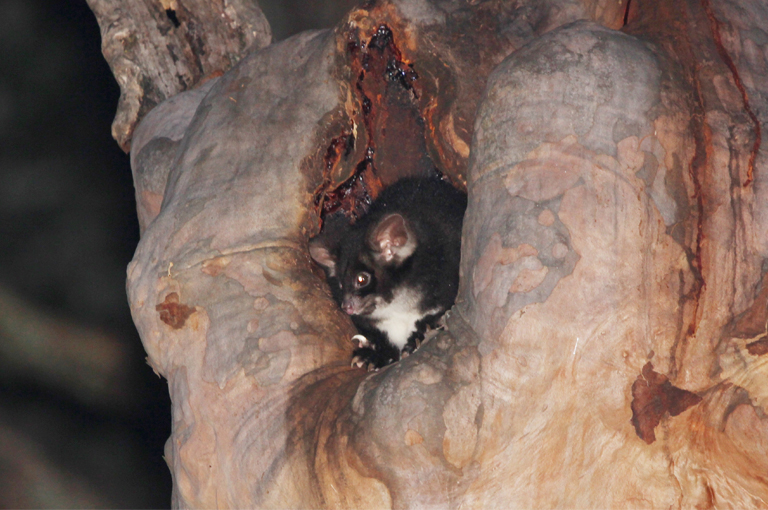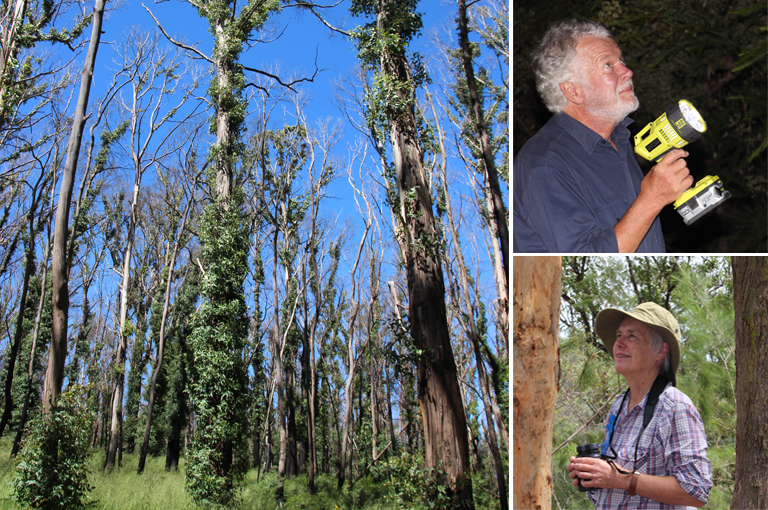
A recent survey in our Kanangra-Boyd to Wyangala partnership area estimates that the 2019-2020 bushfire crisis resulted in a sobering 45% decline in the population of Greater Gliders in the Blue Mountains.
The survey was commissioned by GER and the World Wide Fund for Nature-Australia as part of our joint project – Cores, Corridors and Koalas. The project is supporting GER’s regional partner networks to restore habitat for forest-dependent native animals post-fire in ten priority locations across eastern Australia.
Local ecologists and glider experts, Dr Peter and Dr Judy Smith, used spotlighting and wildlife cameras to survey six burnt sites at Wombeyan and Jenolan between November and December 2020. Pre-fire surveys of the region’s tree-dwelling mammals were used for comparison.
“Sadly, we found a significant decline in the population of Greater Gliders in the research area. From this, we have estimated that the overall reduction in the greater glider population of the Greater Blue Mountains World Heritage Area as a result of the fires alone was around 45%,” Dr Peter Smith said.
“When we also factor in the impacts of the prolonged drought and heatwaves on Greater Glider numbers, that figure rises to an even more devastating 60% estimated overall decline.”
Greater gliders are the world’s largest gliding marsupial. Using a membrane that stretches from their elbow to their ankle, they can sail between trees for up to 100m at a time.
Their teddy bear like appearance caught the attention of people around the globe during the fires which took a significant toll on the vulnerable species. This comes after many years of drought which is feared to have already heavily impacted glider populations.

Gary Howling, CEO of the Great Eastern Ranges Initiative, said: “The research highlights the need for the Great Eastern Ranges Initiative and the importance of the wildlife corridors that are contributing towards our vision, such as the 320,000 hectare Kanangra-Boyd to Wyangala (K2W) Link.
“The K2W Link provides a refuge for a significant number of glider species and was largely unaffected by the 2019-2020 bushfires.
“This corridor will significantly boost the recovery of the Blue Mountains. It forms a natural highway enabling gliders and other wildlife to safely move across the landscape to repopulate the World Heritage Area. Having a network of connected habitat in these areas provides insurance populations of threatened species,” he said.
Dr Kita Ashman, WWF-Australia Threatened Species and Climate Adaptation Ecologist said the report adds to the growing awareness about the impact of fires on greater gliders following years of drought and heatwaves.
“It is alarming that more than half the Blue Mountains greater glider population may have perished. They are one of several species heavily impacted by the bushfires,” she said.
“WWF is supporting the Great Eastern Ranges Initiative through our Regenerate Australia plan – the largest wildlife and nature regeneration program in the nation’s history.
“By working with a wide range of partners, like GER, to regenerate and restore habitat, WWF will help greater gliders, koalas and other species to recover after last year’s fires,” she said.
Additional funding is needed to expand on the critical post-fire recovery work that is being carried out through the WWF-GER partnership across eastern Australia. Contributions to Cores, Corridors and Koalas can be made online at www.ger.org.au/donations.



 Media release
Media release